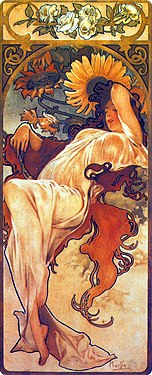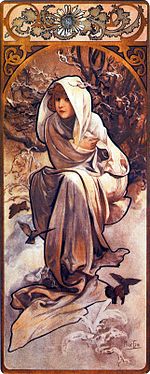
Art Nouveau, Jugendstil in German, is an international style of art, architecture, and applied art, especially the decorative arts. It was often inspired by natural forms such as the sinuous curves of plants and flowers. Other characteristics of Art Nouveau were a sense of dynamism and movement, often given by asymmetry or whiplash lines, and the use of modern materials, particularly iron, glass, ceramics and later concrete, to create unusual forms and larger open spaces. It was popular between 1890 and 1910 during the Belle Époque period, and was a reaction against the academicism, eclecticism and historicism of 19th century architecture and decorative art.

Alfons Maria Mucha, known internationally as Alphonse Mucha, was a Czech painter, illustrator, and graphic artist. Living in Paris during the Art Nouveau period, he was widely known for his distinctly stylized and decorative theatrical posters, particularly those of Sarah Bernhardt. He produced illustrations, advertisements, decorative panels, as well as designs, which became among the best-known images of the period.

The Nabis were a group of young French artists active in Paris from 1888 until 1900, who played a large part in the transition from Impressionism and academic art to abstract art, symbolism and the other early movements of modernism. The members included Pierre Bonnard, Maurice Denis, Paul Ranson, Édouard Vuillard, Ker-Xavier Roussel, Félix Vallotton, Paul Sérusier and Auguste Cazalis. Most were students at the Académie Julian in Paris in the late 1880s. The artists shared a common admiration for Paul Gauguin and Paul Cézanne and a determination to renew the art of painting, but varied greatly in their individual styles. They believed that a work of art was not a depiction of nature, but a synthesis of metaphors and symbols created by the artist. In 1900, the artists held their final exhibition and went their separate ways.
The Four Seasons, originally referring to the traditional seasons of spring, summer, autumn, and winter, may refer to:
The year 1895 in art involved some significant events.

JOB rolling papers are a popular brand of cigarette paper produced by Republic Tobacco in Perpignan, France.

The Slav Epic is a cycle of 20 large canvases painted by Czech Art Nouveau painter Alphonse Mucha between 1910 and 1928. The cycle depicts the mythology and history of Czechs and other Slavic peoples. In 1928, after finishing his monumental work, Mucha bestowed the cycle upon the city of Prague on the condition that the city build a special pavilion for it.

Henri Meunier was a Belgian Art Nouveau lithographer, etcher, illustrator, bookbinder and poster designer of the Belle Époque.

L'Estampe Moderne appeared in 1897-1899 as a series of 24 monthly fascicles, each of 4 original lithographs, priced at 3 francs 50 centimes and printed by Imprimerie Champenois of Paris. Many accomplished European Art Nouveau painters contributed works to this publication. The richly lithographed prints had as a blindstamp, the imprint of a young woman's profile in the lower right corner. The prints are much sought after in the current art world.

Paul Berthon was a French artist who produced primarily posters and lithographs.
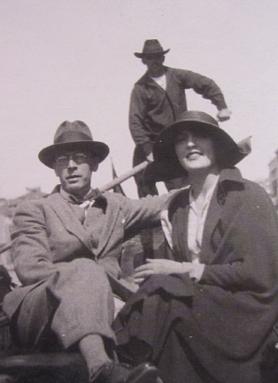
Marcello Dudovich was an Italian painter, illustrator, and poster designer. Together with Leonetto Cappiello, Adolfo Hohenstein, Giovanni Maria Mataloni and Leopoldo Metlicovitz he is considered one of the progenitors of Italian poster design.
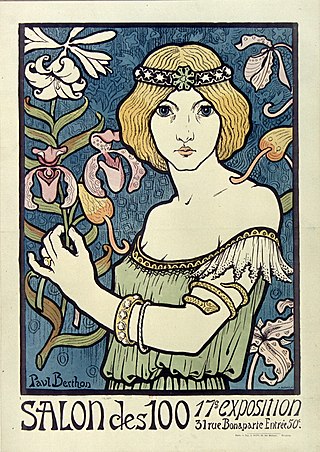
Salon des Cent was a commercial art exhibition in Paris, based at 31 Rue Bonaparte. The Salon sold color posters, prints and reproductions of artwork to the general public at reasonable prices. It was established in February 1894 by Léon Deschamps, founder of La Plume an avant garde literary and artistic magazine. It became known for its exhibitions showcasing the works of contemporary graphical artists. The salon held exhibitions until 1900. Many of the posters advertising Salon des Cent exhibitions have themselves become collectors' items.
Fernand-Louis Gottlob was a French graphic artist whose caricatures appeared in many humorous magazines.

Armand Point was a French painter, engraver and designer who was associated with the Symbolist movement and was one of the founders of the Salon de la Rose + Croix. Later he formed his own atelier. Sources differ over the details of his birth and death.

Art Nouveau posters and graphic arts flourished and became an important vehicle of the style, thanks to the new technologies of color lithography and color printing, which allowed the creation of and distribution of the style to a vast audience in Europe, the United States and beyond. Art was no longer confined to art galleries, but could be seen on walls and illustrated magazines.
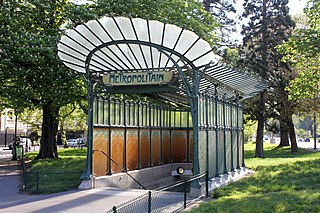
The Art Nouveau movement of architecture and design flourished in Paris from about 1895 to 1914, reaching its high point at the 1900 Paris International Exposition. with the Art Nouveau metro stations designed by Hector Guimard. It was characterized by a rejection of historicism and traditional architectural forms, and a flamboyant use of floral and vegetal designs, sinuous curving lines such as the whiplash line, and asymmetry. It was most prominent in architecture, appearing in department stores, apartment buildings, and churches; and in the decorative arts, particularly glassware, furniture, and jewelry. Besides Guimard, major artists included René Lalique in glassware, Louis Majorelle in furniture, and Alphonse Mucha in graphic arts, It spread quickly to other countries, but lost favor after 1910 and came to an end with the First World War.

The whiplash or whiplash line is a motif of decorative art and design that was particularly popular in Art Nouveau. It is an asymmetrical, sinuous line, often in an ornamental S-curve, usually inspired by natural forms such as plants and flowers, which suggests dynamism and movement. It took its name from a woven fabric panel "Cyclamen", by the German artist Hermann Obrist (1895) which depicted the stems and roots of the cyclamen plant, which critics dubbed "Coup de Fouet" ('whiplash'). The panel was later reproduced by the textile workshop of the Darmstadt Artists Colony.

Jeanne Louise Marie Euphrasie Atché, known as Jane was a French painter and poster artist in the Art Nouveau style.

The JOB collection is a production of graphic works consisting of calendars, posters and postcards advertising the JOB rolling paper factory. Artistic in character, it was illustrated by renowned painters and poster artists, mainly during the Art Nouveau period.

The Mucha Museum is a museum in Prague, Czech Republic, housing a collection of works by Alphonse Mucha.





